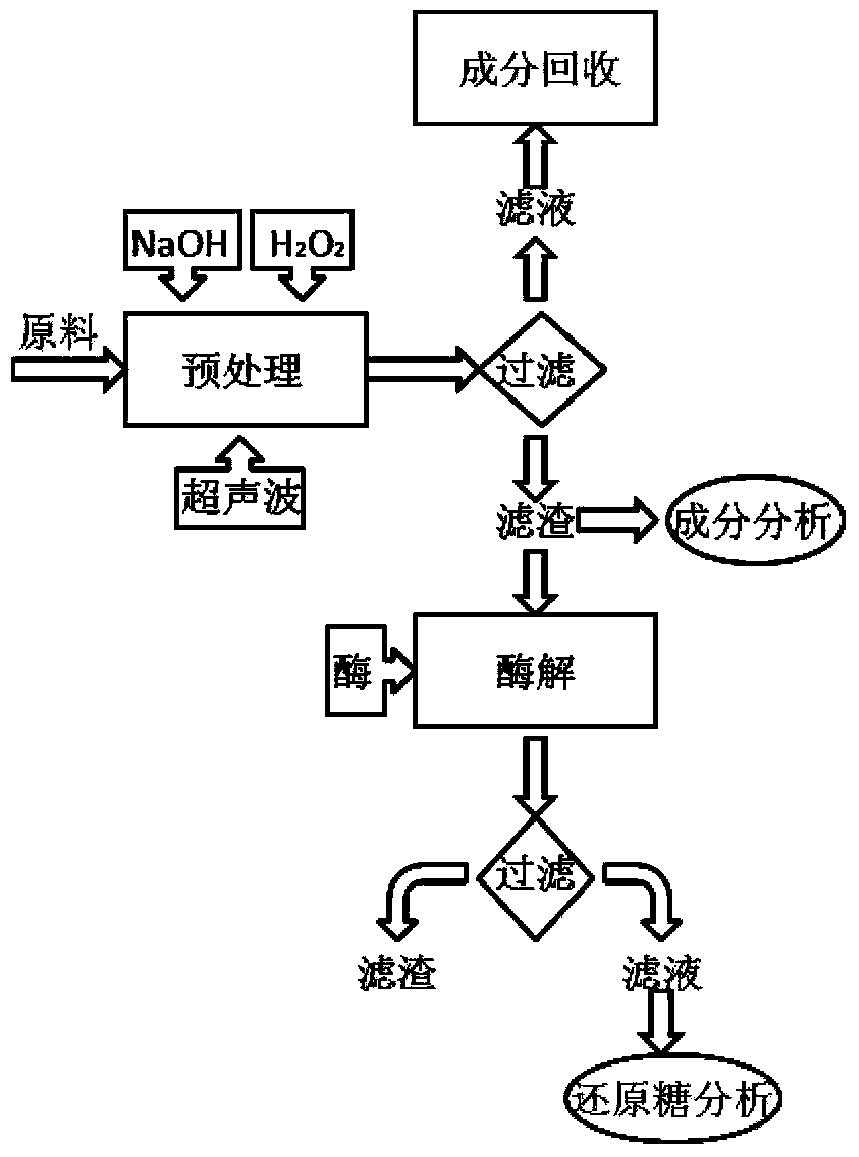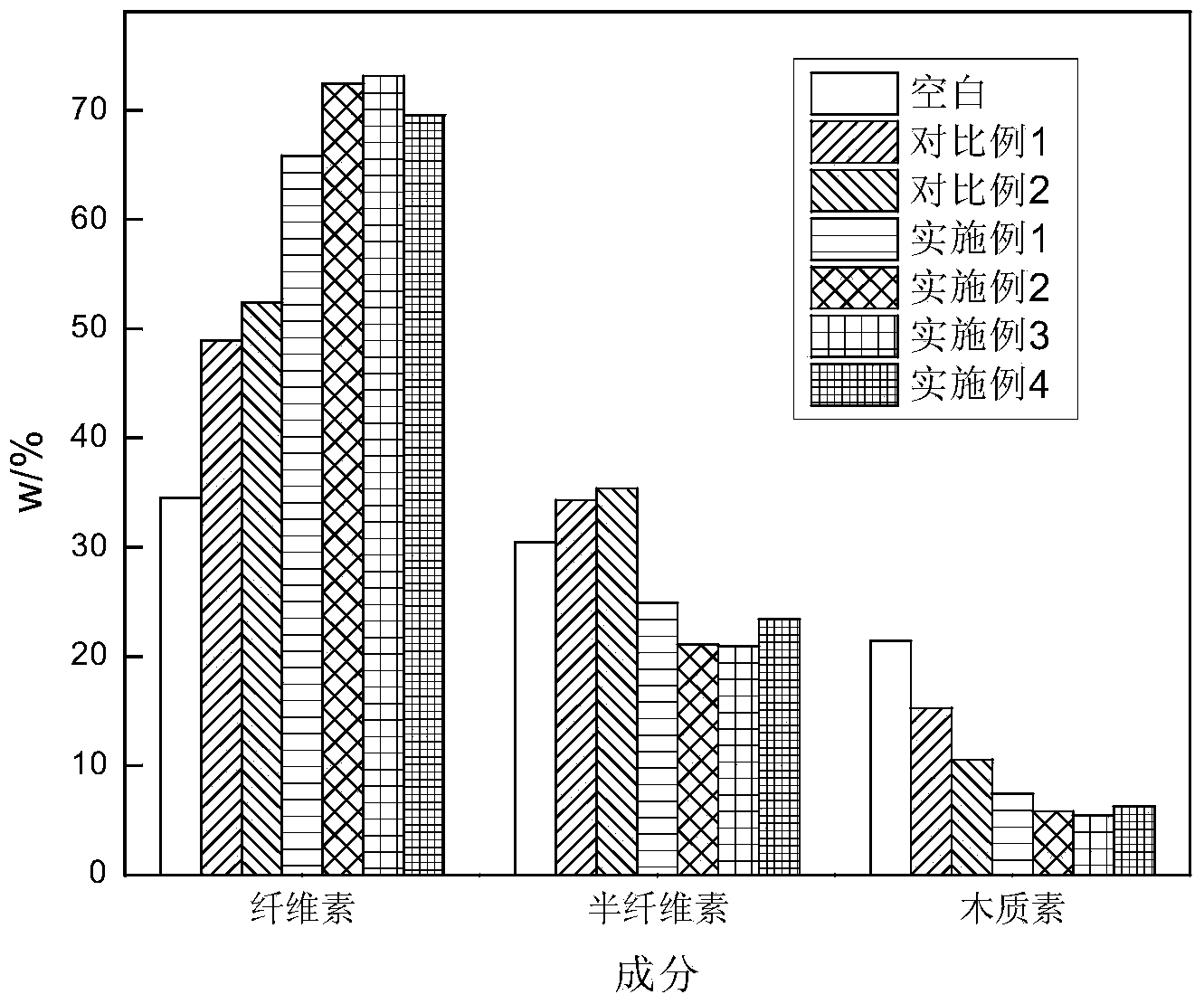Method for pretreating lignocellulose at low temperature through coupling of sodium hydroxide and ethanol
A lignocellulose and low-temperature pretreatment technology, applied in the field of biomass resource utilization, can solve the problems of high pretreatment temperature, achieve the effects of short action time, increase ethanol yield, and increase the yield of enzymatic hydrolysis of raw materials
- Summary
- Abstract
- Description
- Claims
- Application Information
AI Technical Summary
Problems solved by technology
Method used
Image
Examples
Embodiment 1
[0035] Weigh 10g of corncob after drying and pass through a 40-mesh sieve, add 100ml of a mixed solution containing 0.25mol / L NaOH solution and 50% (v / v) ethanol in a beaker, the reaction temperature is 60℃, and the reaction time is 1h. After the reaction, the slurry is vacuum filtered to achieve solid-liquid separation, and the filter residue produced above is washed with distilled water until the pH value is neutral, and dried at 105° C. to constant weight.
[0036] The pretreated corncob was subjected to Van Soest determination (the main components are as follows: figure 2 Shown) and enzymatic hydrolysis, wherein the enzymatic hydrolysis conditions are: solid-liquid ratio 1:70 (g / mL), time 72h, temperature 50℃, pH 4.8 citric acid-sodium citrate buffer solution, cellulase It is produced by Trichoderma reesei, and its loading is 25FPU / g dry raw material. After enzymolysis, the reaction slurry was taken out, the enzyme was inactivated in a boiling water bath for 10 minutes, an...
Embodiment 2
[0038] Weigh 10g of corncob after drying and pass through a 40-mesh sieve, add 100ml of a mixed solution containing 0.50mol / L NaOH solution and 50% (v / v) ethanol in a beaker. The reaction temperature is 60℃ and the reaction time is 1h. After the reaction, the slurry is vacuum filtered to achieve solid-liquid separation, and the filter residue produced above is repeatedly washed with distilled water until the pH value is neutral, and dried at 105° C. to a constant weight.
[0039] The pretreated corncob was subjected to Van Soest determination (the main components are as follows: figure 2 Shown) and enzymatic hydrolysis, wherein the enzymatic hydrolysis conditions are: solid-liquid ratio 1:70 (g / mL), time 72h, temperature 50℃, pH 4.8 citric acid-sodium citrate buffer solution, cellulase It is produced by Trichoderma reesei, and its loading is 25FPU / g dry raw material. After the enzymolysis, the reaction slurry was taken out, and the enzyme was inactivated in a boiling water bat...
Embodiment 3
[0041] Weigh 10g of corncob after drying and pass through a 40-mesh sieve, add 150ml of a mixed solution containing 0.50mol / L NaOH solution and 50% (v / v) ethanol in a beaker, the reaction temperature is 60℃, and the reaction time is 1h. After the reaction, the slurry is vacuum filtered to achieve solid-liquid separation, and the filter residue produced above is repeatedly washed with distilled water until the pH value is neutral, and dried at 105° C. to a constant weight.
[0042] The pretreated corncob was subjected to Van Soest determination (the main components are as follows: figure 2 Shown) and enzymatic hydrolysis, wherein the enzymatic hydrolysis conditions are: solid-liquid ratio 1:70 (g / mL), time 72h, temperature 50℃, pH 4.8 citric acid-sodium citrate buffer solution, cellulase It is produced by Trichoderma reesei, and its loading is 25FPU / g dry raw material. After the enzymolysis, the reaction slurry was taken out, and the enzyme was inactivated in a boiling water ba...
PUM
 Login to View More
Login to View More Abstract
Description
Claims
Application Information
 Login to View More
Login to View More - R&D
- Intellectual Property
- Life Sciences
- Materials
- Tech Scout
- Unparalleled Data Quality
- Higher Quality Content
- 60% Fewer Hallucinations
Browse by: Latest US Patents, China's latest patents, Technical Efficacy Thesaurus, Application Domain, Technology Topic, Popular Technical Reports.
© 2025 PatSnap. All rights reserved.Legal|Privacy policy|Modern Slavery Act Transparency Statement|Sitemap|About US| Contact US: help@patsnap.com


